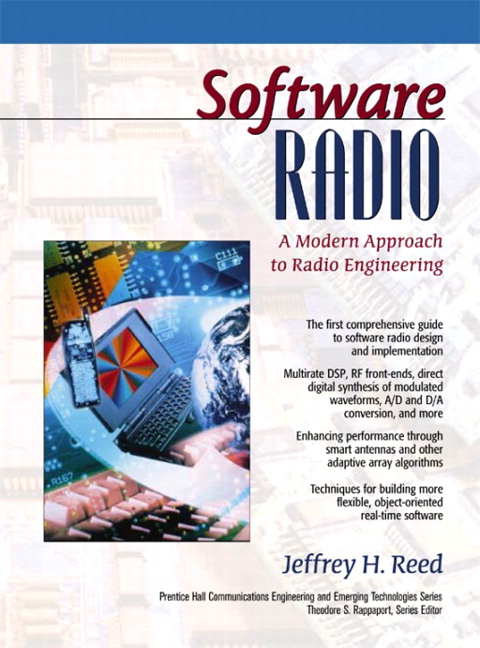Textbook:
[1]
Jeffrey H. Reed
Software Radio: A Modern Approach to Radio Engineering
Publisher: Prentice Hall PTR; May 2002
ISBN: 0130811580

EE568: Software Defined Radio
Instructor: Prof. Yu-Dong Yao
E-mail:
yyao@stevens.edu,
|
Textbook:
Jeffrey H. Reed Software Radio: A Modern Approach to Radio Engineering Publisher: Prentice Hall PTR; May 2002 ISBN: 0130811580
|
 |
Other Recommended Readings:
Grading:
Homework 25%
Term paper 20%
Midterm (open book) 25%
Final (open book) 30%
About late HW: For late HW submission, you get 75% HW grade.
Course Description:
This course offers an introduction to software defined radios, devices that can be programmed to work with a variety of different radios. The course covers the following topics: software radio architectures, existing software radio efforts, a review of basic receiver design principles and application to software radios. Basic questions, design tradeoffs, and architectural issues are also discussed. Several case studies of software radios will be discussed throughout the course.
Course Objectives:
Topical Outline:
|
Week |
Topic |
Textbook chapter |
|
1 |
Lec.1: "1: Introduction to SDR" The Need for Software Radios. What Is a Software Radio? Characteristics and Benefits of a Software Radio. Design Principles of a Software Radio.
|
1 |
|
2 |
Lec.2: "Radio frequency implementation issues" The Purpose of the RF Front-End. Dynamic Range: The Principal Challenge of Receiver Design. RF Receiver Front-End Topologies. Enhanced Flexibility of the RF Chain with Software Radios. Importance of the Components to Overall Performance. Transmitter Architectures and Their Issues. Noise and Distortion in the RF Chain. ADC and DAC Distortion.
|
2 |
|
3 |
Lec.3: "Multirate signal processing" Introduction. Sample Rate Conversion Principles. Polyshase Filters. Digital Filter Banks. Timing Recovery in Digital Receivers Using Multirate Digital Filters.
|
3 |
|
4 |
Lec.4: "Digital generation of signals" Introduction. Comparison of Direct Digital Synthesis with Analog Signal Synthesis. Approaches to Direct Digital Synthesis. Analysis of Spurious Signals. Spurious Components due to Periodic Jitter. Bandpass Signal Generation. Performance of Direct Digital Synthesis Systems. Hybrid DDS-PLL Systems. Applications of direct Digital Synthesis. Generation of Random Sequences. ROM Compression Techniques.
|
4 |
|
5 |
Lec.5: "Analog to digital and digital to analog conversion (Part 1)" Parameters of ideal data converters; Parameters of practical data converters;
|
5 |
|
6 |
Lec.6: "Analog to digital and digital to analog conversion (Part 2)" Techniques to improve data converter performance; Common ADC and DAC architectures
|
5 |
|
7 |
Midterm
|
|
|
8 |
Project assignment
|
|
|
8 |
Lec.7: "Smart antennas (Part 1)" Vector channel modeling; Benefits of smart antennas; Structures for Beamforming Systems; Smart Antenna Algorithms.
|
6 |
|
9 |
Lec.8: "Smart antennas (Part 2)" Diversity and Space-Time Adaptive Signal Processing; Algorithms for Transmit STAP; Hardware Implementation of Smart Antennas; Array Calibration.
|
6 |
|
10 |
Lec.9: "Digital hardware choices" Introduction; Key Hardware Elements; DSP Processors; Field Programmable Gate Arrays; Trade-Offs in Using DSPs, FPGAs, and ASICs; Power Management Issues; Using a Combination of DSPs, FPGAs, and ASICs.
|
7 |
|
11 |
Lec.10: "Object-oriented representation of radios and network resources" Networks; Object-Oriented Programming; Object Brokers; Mobile Application Environments; Joint Tactical Radio System.
|
8 |
|
12 |
Lec.11: "Case studies in software radio design (Part 1)" Introduction and a Historical Perspective; SPEAKeasy; JTRS; Wireless Information Transfer System.
|
9 |
|
13 |
Lec.12: "Case studies in software radio design (Part 2)" SDR-3000 Digital Transceiver Subsystem; SpectrumWare; CHARIOT.
|
9 |
|
14 |
Final
|